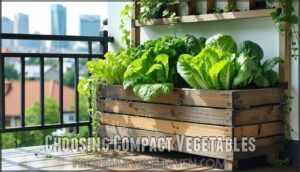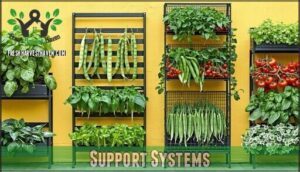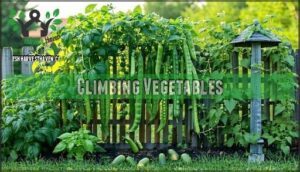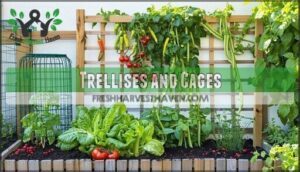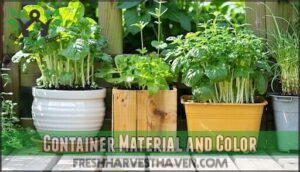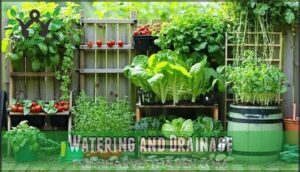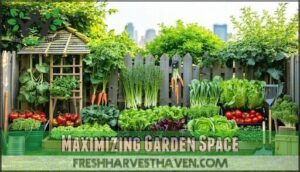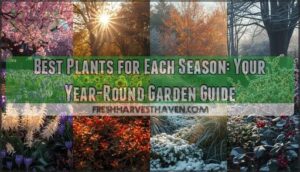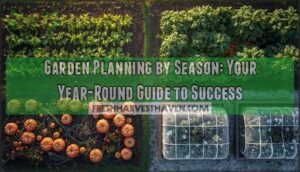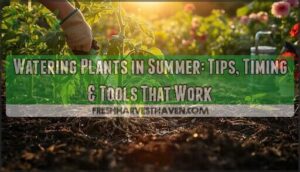This site is supported by our readers. We may earn a commission, at no cost to you, if you purchase through links.
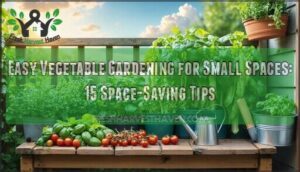
Easy vegetable gardening for small spaces starts with selecting compact varieties like cherry tomatoes, leafy greens, and climbing beans that maximize your harvest per square foot.
Use containers, vertical trellises, and succession planting to keep fresh produce flowing from your balcony or patio.
Focus on fast-growing crops like radishes and lettuce that’ll give you quick wins while your longer-season vegetables develop.
The secret isn’t having more space—it’s making every inch count through strategic planning and the right growing methods, which is the key to productive garden and smart plant choices.
Table Of Contents
- Key Takeaways
- Small Space Gardening
- Choosing Compact Vegetables
- Vertical Gardening Techniques
- Container Gardening Tips
- Maximizing Garden Space
- Frequently Asked Questions (FAQs)
- What are the best small vegetable garden ideas?
- How do I choose a vegetable garden if I have limited space?
- How to grow vegetables in a small space?
- What can you grow in a small space garden?
- What is a good container vegetable garden idea?
- Do you need a small vegetable garden?
- What vegetables can you grow in a small space?
- What are the easiest vegetables to grow in a small garden?
- What is the best layout for a small vegetable garden?
- What vegetables take the least amount of space to grow?
- Conclusion
Key Takeaways
- Choose compact varieties like cherry tomatoes, leafy greens, and climbing beans that will give you maximum harvest per square foot in containers or small plots.
- Use vertical growing techniques with trellises, cages, and climbing supports to triple your growing space by training vegetables upward instead of outward.
- Apply succession planting by starting new crops every 2-3 weeks so you will have continuous harvests instead of everything ripening at once.
- Focus on container gardening with proper drainage, quality potting mix, and regular feeding since containers dry out faster but give you complete control over growing conditions.
Small Space Gardening
You can grow a surprising variety of vegetables in small spaces with the right techniques and plant choices.
Smart container selection, proper soil preparation, and strategic space utilization turn even tiny balconies into productive gardens, utilizing smart container selection to maximize space.
Sunlight Requirements
Most vegetables need full sun (6-8 hours daily) for ideal growth, but morning sun works best in hot climates.
Partial shade suits leafy greens like lettuce and spinach perfectly.
Check your sunny spots throughout the day—afternoon sun can be too intense for delicate plants.
Window boxes and containers let you chase the light, moving plants as needed.
Understanding sunlight requirements transforms your small space gardening success dramatically.
Watering Needs
Container gardening demands precise water management since pots dry out faster than ground soil.
Container plants thrive with daily attention—your finger becomes the best moisture meter for perfect watering timing.
Check soil moisture daily by inserting your finger two inches deep—if it’s dry, it’s time to water.
Self-watering containers extend intervals by 2-3 days, while drip irrigation systems deliver consistent moisture without overwatering.
Collect rainwater for sustainable watering, and make certain proper drainage systems prevent root rot in your space-saving garden, ensuring a healthy environment with proper drainage.
Soil Quality
Good soil quality starts with understanding what your plants need to thrive.
You’ll want well-drained soil with proper pH levels between 6.0-7.0 for ideal nutrient cycling.
Boost soil health by adding compost—it increases organic matter and improves soil nutrients naturally.
Test your soil regularly to monitor these key factors and adjust your soil management practices accordingly, focusing on soil health.
Fertilizer and Nutrient Needs
With healthy soil established, your plants need proper nutrition to thrive.
Container vegetables require more frequent feeding since nutrients wash away with watering.
Here’s your feeding game plan:
- Organic Fertilizers – Apply compost tea every 2-3 weeks for gentle, steady nutrition
- Nutrient Cycling – Mix slow-release granules into potting mix for 3-month feeding cycles
- Soil pH – Test monthly and adjust between 6.0-7.0 for ideal micro nutrients uptake
Natural fertilizers and composting create nutrient-rich plants while supporting long-term soil health in your organic gardening space.
Choosing Compact Vegetables
You’ll get the most vegetables from your small space when you choose compact varieties that pack maximum nutrition into minimal square footage.
Start with leafy greens like lettuce and spinach, which grow quickly in shallow containers and let you harvest leaves continuously without replanting the entire crop, allowing for continuous harvest.
Leafy Greens and Brassicas
Leafy greens and brassicas pack incredible nutrition into compact spaces.
Kale nutrition includes vitamins A, C, and K, while spinach care requires consistent moisture and cool temperatures.
These compact vegetable plants thrive in containers as shallow as six inches.
Broccoli health benefits make it worth growing despite needing more space.
Your leafy harvest can continue for weeks with proper brassica benefits through cut-and-come-again techniques, which support the overall leafy greens nutrition.
Vining and Climbing Vegetables
Vining vegetables maximize your growing space by reaching skyward instead of sprawling outward. These climbing plants can triple your harvest per square foot compared to bush varieties.
When selecting varieties, consider using climbing vegetable seeds for ideal space usage.
- Cucumber Care: Train vines up trellis support systems for better air circulation and easier harvesting
- Pea Supports: Install sturdy structures early since these climbers start growing immediately after germination
- Vine Pruning: Remove lower leaves regularly to prevent disease and encourage upward growth in compact vegetable plants
Cherry Tomatoes for Small Spaces
Cherry tomatoes pack big flavor into small spaces, making them perfect for container gardening beginners.
These compact growing champions thrive in pots as small as 12 inches, producing sweet, bite-sized fruits throughout the season.
You’ll need sturdy support systems since these prolific plants can reach surprising heights.
With proper cherry tomato care and regular watering, you’ll enjoy continuous fruit harvesting from your space-saving vegetables all summer long.
Cherry tomatoes also benefit from vertical gardening techniques to maximize yields in small areas, which is ideal for small spaces and allows for continuous fruit harvesting.
Radishes for Quick Harvests
Radishes deliver garden-to-table satisfaction in just 30 days, making them perfect for impatient gardeners.
These peppery roots thrive in containers as small as 6 inches deep, requiring minimal soil prep and space.
Here’s your radish success formula:
- Seed Selection: Choose compact varieties like ‘Cherry Belle’ or ‘French Breakfast’ for consistent growth in tight quarters
- Soil Prep: Use loose, well-draining potting mix with neutral pH for ideal root development
- Harvest Tips: Pull radishes when they’re marble-sized to prevent woody texture and bitter flavor
Vertical Gardening Techniques
When you’re working with limited ground space, vertical gardening transforms your small area into a productive growing zone that can increase your harvest by up to 200%.
You’ll use trellises, cages, and climbing supports to train vegetables like peas, cucumbers, and tomatoes upward, freeing valuable square footage for additional plantings, which can lead to a more efficient use of space.
Support Systems
You’ll need reliable support systems to keep your vertical garden thriving.
Trellis systems work perfectly for beans and peas, while cage supports handle heavier tomatoes and peppers.
Staking methods suit single-stem plants, and plant clips secure vines without damage.
Garden arbors create stunning focal points for climbing crops.
Choose sturdy materials that’ll support your plants’ full weight throughout the growing season.
Understanding trellis systems is essential for maximizing space in small gardens, and using the right support is crucial for the growing season.
Climbing Vegetables
Through strategic vertical gardening, you’ll transform climbing vegetables into powerhouse space savers that deliver impressive yields.
Pole beans, peas, and cucumbers naturally reach skyward, maximizing your growing area while minimizing your footprint.
Understanding seed quality factors is vital for healthy growth.
Essential climbing vegetables for compact spaces:
- Pole beans – produce 2-3 times more per square foot than bush varieties
- Sugar snap peas – early spring climbers perfect for pea trellises
- Vining cucumbers – yield up to 10 pounds per plant with proper cucumber support
- Malabar spinach – heat-loving vertical vines reaching 10+ feet on climbing frames
Trellises and Cages
You’ll need sturdy vertical supports to guide your climbing plants upward effectively.
Install trellises made from wood, metal, or plastic against walls or fences for maximum space optimization.
Wire cages work perfectly for tomatoes and peppers, providing 360-degree support while keeping fruits off the ground.
Plant training becomes simple when you gently weave stems through openings weekly, encouraging natural upward growth patterns that maximize your container gardening success.
Effective vertical gardening techniques can substantially increase yields in small spaces, using complete concepts and vertical gardening to achieve success with container gardening and maximum space optimization.
Container Gardening Tips
Container gardening transforms any small space into a productive vegetable haven when you choose the right materials and techniques.
You’ll discover that proper containers, quality soil, and smart watering systems can triple your harvest potential while keeping maintenance simple.
Container Material and Color
Three container materials rule small space gardening: ceramic pots offer excellent drainage and temperature control, wooden planters provide natural insulation for roots, and metal containers heat up quickly in sunny spots.
Plastic alternatives work well but may crack over time. Choose light-colored containers to reflect heat and prevent root damage.
Color schemes matter too—darker pots absorb more heat, potentially stressing your spacesaving plants in compact garden setups.
Proper container gardening techniques, including soil preparation methods, are essential for healthy plant growth.
Soil and Fertilizer Needs
Your container’s soil foundation determines your harvest’s success.
Use high-quality potting mix with 30% organic matter—never garden soil, which compacts and drains poorly.
Maintain soil pH between 6.0-7.0 for ideal nutrient uptake.
Apply slow-release fertilizer every 8-12 weeks, supplementing with liquid fertilizer for quick nutrient cycling.
Regular compost usage boosts soil health and supports nutrient-rich plants in small space gardening.
Watering and Drainage
Proper watering keeps your plants thriving without drowning their roots.
Drainage holes prevent waterlogged soil that kills vegetables faster than drought.
Self-watering containers extend watering intervals while maintaining consistent soil moisture.
Install simple irrigation systems like drip hoses for water conservation in small space gardening.
Consider rainwater harvesting to reduce costs and provide chemical-free water for your container vegetables.
Maximizing Garden Space
You can maximize your garden space through strategic planting techniques that double or triple your harvest without expanding your footprint.
Smart gardening methods like succession planting, interplanting, and companion planting turn even the smallest plots into productive green spaces.
Succession Planting
Succession planting’s magic lies in timing—you’ll harvest fresh vegetables continuously instead of facing feast-or-famine cycles.
This spacesaving technique involves planting new crops every 2-3 weeks, ensuring your small garden produces year-round.
By using a soil health guide, you can optimize your garden’s productivity and maintain its fertility over time.
- Seed starting lettuce and radishes every 14 days maximizes harvest timing
- Crop rotation prevents soil depletion while maintaining plant scheduling efficiency
- Seasonal planting extends growing seasons through strategic soil preparation methods
Interplanting
Maximize your harvest by planting quick-growing crops like radishes between slower vegetables such as tomatoes.
This intercropping technique uses every inch of soil, boosting yields while different root depths prevent competition.
You’ll harvest radishes before tomatoes need the space, creating efficient polyculture systems that make small space gardening incredibly productive.
Companion Planting
Smart plant pairings create garden harmony while maximizing your small space.
You’ll boost yields when combining compatible crops like tomatoes with basil, or lettuce with radishes. These plant partners share soil nutrients efficiently and provide natural pest control.
Marigolds repel harmful insects while beans fix nitrogen for neighboring plants. Strategic companion planting turns your compact garden into a thriving ecosystem where every square inch works harder.
By implementing effective soil fertility methods, gardeners can optimize their plant pairings for maximum growth and productivity.
Overcoming Common Problems
Small vegetable gardening challenges don’t have to derail your harvest. Common issues like pest invasions and nutrient deficiencies respond well to preventive measures and quick action.
- Pest Control: Apply neem oil weekly to prevent aphid and spider mite infestations before they damage your crops.
- Disease Prevention: Space plants 6 inches apart to improve airflow and reduce fungal problems by 60%.
- Soil Erosion: Use mulch around containers to retain moisture and prevent nutrient washout during heavy watering.
- Weed Management: Pull weeds immediately—they compete for nutrients and can reduce yields by 40% in small spaces.
Frequently Asked Questions (FAQs)
What are the best small vegetable garden ideas?
Container gardening transforms tight spaces into productive growing areas.
Try vertical trellises for climbing vegetables like peas and cucumbers, use stackable planters for leafy greens, and choose compact varieties like cherry tomatoes and herbs for maximum yield.
How do I choose a vegetable garden if I have limited space?
Like medieval peasants tending tower gardens, you’ll thrive with container gardening’s flexibility.
Choose compact varieties like cherry tomatoes, lettuce, and herbs that flourish in small pots, then stack vertically to triple your growing space efficiently, with compact varieties being the key to success.
How to grow vegetables in a small space?
Maximize your harvest by choosing fast-growing vegetables like radishes, lettuce, and spinach for containers.
Use vertical trellises for climbing crops like peas and cucumbers, and select compact varieties that thrive in small pots with proper drainage, to ensure a successful and bountiful harvest.
What can you grow in a small space garden?
You’ll be amazed at what fits in compact spaces.
Lettuce, radishes, and herbs thrive in containers just 12 inches wide, while cherry tomatoes and kale maximize vertical growth with proper support systems.
What is a good container vegetable garden idea?
Try growing cherry tomatoes, lettuce, and herbs in deep containers with drainage holes. You’ll harvest fresh produce from your balcony or patio while enjoying the satisfaction of homegrown vegetables.
Do you need a small vegetable garden?
Small vegetable gardens offer you control over your food supply, reduce grocery costs, and provide fresh produce right outside your door.
You’ll gain gardening skills while enjoying the satisfaction of growing your own nutritious vegetables in limited space.
What vegetables can you grow in a small space?
Like seeds finding cracks in concrete, compact vegetables thrive in containers.
You’ll grow radishes, lettuce, spinach, cherry tomatoes, carrots, kale, beets, broccoli, Swiss chard, turnips, plus herbs like basil, thyme, and mint successfully.
What are the easiest vegetables to grow in a small garden?
Radishes, lettuce, and spinach top the beginner-friendly list since they’re virtually foolproof and ready to harvest in just weeks. These cool-weather champions thrive in containers and forgive occasional watering mistakes.
What is the best layout for a small vegetable garden?
Picture your garden as a chess board where every square counts – strategic placement transforms cramped spaces into productive powerhouses.
Use square foot gardening with 12-inch sections, stack containers vertically, and position tall plants north to prevent shading shorter crops below.
What vegetables take the least amount of space to grow?
You’ll get maximum harvest from radishes, lettuce, and spinach since they’re compact, quick-growing crops.
These leafy greens thrive in containers just 6-8 inches deep, letting you squeeze more plants into tight spaces.
Conclusion
Picture yourself harvesting fresh tomatoes from your balcony railing while herbs cascade down your apartment wall.
Easy vegetable gardening for small spaces transforms any compact area into a productive growing zone. You’ll discover that strategic planning beats square footage every time.
These fifteen space-saving techniques give you the tools to maximize yields through vertical growing, succession planting, and smart container choices.
Your small space garden will outperform many traditional plots when you apply these proven methods.
- https://costafarms.com/pages/about-costa-farms
- https://www.thespruce.com/succession-planting-11693554
- https://www.johnnyseeds.com/growers-library/methods-tools-supplies/market-gardening/succession-planting-interval-chart-vegetables.html
- https://www.gardenary.com/blog/extend-your-growing-season-and-maximize-your-harvests-with-successive-sowing
- https://dug.org/gardening-resources/succession-planting/

